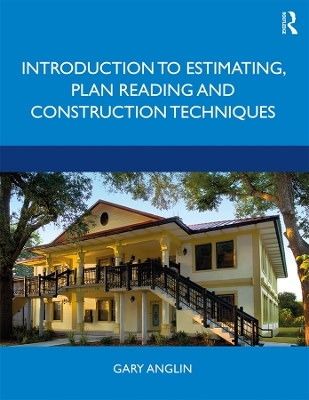
Introduction to Estimating, Plan Reading and Construction Techniques
Routledge (Verlag)
978-0-367-20903-2 (ISBN)
Plans: Scale drawings of floor plans, sections, or elevations.
Plan Interpretation: The drawings are explained with comments.
Scope of the Work: A written description of the boundaries of the work is given for each section.
Construction Techniques: The construction processes and their sequence are explained.
The Takeoff: A takeoff is shown at the end of each section.
This approach helps foster confidence in plan reading, building methods, arithmetic, takeoffs, and estimates. The various products and terms used in the industries of structural steel, doors and hardware, and roofing are defined. The shop drawing process is explained, which is so important in many industries, as well as the role of and difference between manufacturers, fabricators, and suppliers/distributors. The book ends with a study of "front end" documents, including Division 00 General Conditions, AIA 201, and Division 01 General Requirements, and a chapter on Ethics. This textbook can be used to teach a variety of classes including plan reading, construction techniques, and estimating 1 and 2 (takeoffs and pricing).
Gary Anglin is a construction firm owner with over 35 years' experience and former Adjunct Professor at the Rinker School of Building Construction, University of Florida, USA.
Introduction
Section 1 How Parts 3, 4, and 6 are covered in this textbook
Section 2 Plans and sketches for Parts 3, 4, and 6
Section 3 Plan interpretation of Parts 3, 4, and 6
Section 4 Scopes of work for Parts 3, 4, and 6
Section 5 Construction techniques for Parts 3, 4, and 6
Section 6 Takeoff formats of Parts 3, 4, and 6
Section 7 How Parts 5, 7, 8, 9, and 10 are covered in this textbook
Section 8 Terminology
Section 9 Parts 11 and 12, contract documents and ethics
PART 1: Plans and specifications
1 Reading plans
Section 1 Drawing illustrations
Section 2 The interpretation of plans
2 Plan types
Section 1 Introduction
Section 2 Architects and engineers
Section 3 Plan iterations from schematic to permit sets
Section 4 Civil engineering plan sets
Section 5 Architectural plan sets
Section 6 Structural plan sets
Section 7 Mechanical plan sets
Section 8 Plan Revisions
3 The specifications
Section 1 Introduction
Section 2 The old 16 divisions and the new CSI master format
Section 3 Three parts of every specification
PART 2: Estimating
1 Quantities
Section 1 Quantity surveys or takeoffs?
Section 2 Takeoff rules and standard procedures
Section 3 Summary
2 Pricing
Section 1 Introduction
Section 2 Unit price sheet
Section 3 P/S sheet
Section 4 Church estimate
3 A short history of bonding and liens
Section 1 The Heard and Miller acts
Section 2 Bid bonds
Section 3 Payment bonds
Section 4 Performance bonds
Section 5 Bonding companies
Section 6 Liens
PART 3: Concrete
1 Introduction
Section 1 Ruling body, the American Concrete Institute
Section 2 Form reinforce and pour
Section 3 Concrete takeoffs
Section 4 Formwork takeoffs
Section 5 Concrete reinforcement
Section 6 Excavation and grading
Section 7 Summary
2 Isolated concrete pads
Section 1 Drawings and photos of concrete pads
Section 2 Earthforming concrete pads
Section 3 Overexcavation and edgeform concrete pads up to 12″ high
Section 4 Plywood forms for concrete pads over 12″ high
3 Continuous concrete footings
Section 1 Photos and drawing(s)
Section 2 Centerlines and rectangles
Section 3 Footings and backfill
Section 4 Footing stepdowns
4 Slabs on grade
Section 1 Photos and drawing(s)
Section 2 Fill dirt and slab thickened edges
Section 3 Thickened slabs
Section 4 Embeds
5 Monolithic slabs
Section 1 Photos and drawing(s)
Section 2 Changing triangles into rectangles
Section 3 Brick ledges
Section 4 Basketball courts and keyways
6 Concrete walls
Section 1 Photos and drawing(s)
Section 2 Wall formwork design
Section 3 Blockouts
Section 4 Retaining walls and waterstop
Section 5 Concrete walls
7 Concrete columns
Section 1 Photos and drawing(s)
Section 2 Foundation piers
Section 3 Columns, chamfer strips, and recesses
8 Concrete beams
Section 1 Photos and drawing(s)
Section 2 Tie beams and beam bottoms
Section 3 Concrete beams
Section 4 Rake beams
9 Elevated concrete slabs
Section 1 Photos and drawing(s)
Section 2 Slab on deck
Section 3 Second floor porch and stairs
PART 4: Masonry
1 Products and metrics
Section 1 Introduction
Section 2 Masonry contractors and products
Section 3 Block openings
Section 4 Counting block
Section 5 Counting concrete in blocks
Section 6 Bricks
2 Foundation blocks
Section 1 Photos and drawing(s)
Section 2 Header blocks
Section 3 Elevator shaft
Section 4 Lintel blocks
3 Single-story block walls
Section 1 Photos and drawing(s)
Section 2 Block wall case study
Section 3 Wall length quiz
Section 4 Bond beams and precast U lintels
Section 5 Block columns and outs
4 Multiple block wall heights
Section 1 Photos and drawing(s)
Section 2 Material bin block walls
Section 3 Block walls and door headers
Section 4 Block walls
5 Sloping block walls
Section 1 Photos and drawing(s)
Section 2 12″ block
Section 3 Special block
6 Brick
Section 1 Photos and drawing(s)
Section 2 Brick veneer
Section 3 Solid brick walls
PART 5: Steel
1 Structural steel
Section 1 Introduction
Section 2 The AISC and the steel manual
Section 3 Drawings
Section 4 Subcontractors and suppliers
Section 5 Structural steel products
Section 6 Steel connections
Section 7 Construction techniques
Section 8 Estimating
Section 9 A short history of American steel
2 Steel joists and steel decks
Section 1 Introduction
Section 2 Ruling bodies, SJI and SDI
Section 3 Steel joist products and profiles
Section 4 Steel deck products and profiles
Section 5 Steel joist designations and characteristics
Section 6 Joist and deck suppliers and contractors
Section 7 Joist and deck plans
Section 8 Steel joist bearing, bridging, and extensions
Section 9 Construction techniques
Section 10 Joist and deck fireproofing
Section 11 Estimating
3 Miscellaneous steel
Section 1 Introduction
Section 2 Shop drawings
Section 3 Wrought iron architecture and ornamental metals
Section 4 Fabrication
Section 5 Handrails and guardrails
Section 6 Bollards
Section 7 Stairwells and metal pans
Section 8 Campus stair tower plans
Section 9 Stair tower takeoff
Section 10 Photo of three misc. steel projects
PART 6: Carpentry
1 Products and metrics
Section 1 Introduction
Section 2 Wood components not shown on plans
Section 3 Lumber types and metrics
Section 4 Units of measure
Section 5 Conversion factors
Section 6 Measuring areas and lengths of inclined surfaces
Section 7 Carpentry takeoffs
Section 8 Waste factors
2 Floor framing
Section 1 Photos and drawing(s)
Section 2 Boardwalk
Section 3 First floor framing
Section 4 Second floor framing
3 Wall framing
Section 1 Photos and drawing(s)
Section 2 Frame wall case study
Section 3 4″, 6″, and 12″ stud walls
Section 4 Three-wall addition
Section 5 Two-story platform framing
Section 6 Sloping walls
4 Ceiling and roof framing
Section 1 Photos and drawing(s)
Section 2 Roof framing case study
Section 3 Trusses, sheathing, and soffit
Section 4 Ceiling joists and chases
Section 5 Roof framing
PART 7: Thermal and moisture protection
1 Asphalt shingles
Section 1 Introduction
Section 2 The shingle product
Section 3 Construction techniques
Section 4 Estimating
2 Metal flashing
Section 1 Introduction
Section 2 Common flashings
Section 3 Wall flashing
Section 4 Curbs and gutters
3 Metal roofing
Section 1 Introduction
Section 2 Substrates for metal roofs
Section 3 Architectural metal panels
Section 4 Structural metal panels
Section 5 Metals and metal problems
4 Moisture protection and waterproofing
Section 1 Introduction
Section 2 Vapor barriers (retarders)
Section 3 Waterproofing and dampproofing
Section 4 Estimating
PART 8: Door and window openings
1 Doors, frames, and hardware
Section 1 Introduction
Section 2 Ruling body, the Door and Hardware Institute
Section 3 Suppliers and distributors
Section 4 Door frames
Section 5 Plans and door schedules
Section 6 Submittals and shop drawings
Section 7 Egress and fire ratings
Section 8 Lock terminology
Section 9 Construction techniques
Section 10 Dudley job estimate
PART 9: Finishes
1 Metal studs
Section 1 Introduction
Section 2 Ruling bodies, SSMA and SFIA
Section 3 Designations
Section 4 Products
Section 5 Estimating
Section 6 Wood blocking
2 Gypsum board
Section 1 Introduction
Section 2 Ruling body, the Gypsum Association
Section 3 Gypsum products
Section 4 Gypsum identification
Section 5 Handling and storage
Section 6 Smoke barriers
Section 7 Fire resistance
Section 8 Techniques
Section 9 Joint compound
Section 10 Estimating
PART 10: Specialties
Section 1 Introduction
Section 2 Suppliers and distributors
Section 3 Submittals
Section 4 Wood blocking
Section 5 Schoolhouse plans, specifications, and legends
Section 6 Schoolhouse estimate
PART 11: Construction documents
1 What is (and isn’t) a contract document
Section 1 Construction documents
Section 2 The project manual
Section 3 The drawings and technical specifications
Section 4 Addenda
Section 5 The generals and their conditions
Section 6 The contract between owner and contractor, articles 5.3.1, 1.1.1, 1.1.2
2 Division 00 General Conditions
Section 1 Introduction
Section 2 Owners and users of facilities
Section 3 The architect’s authority
Section 4 The contractor’s responsibility
Section 5 The contractor’s submittals
Section 6 Change orders
Section 7 Claims
Section 8 Delays
Section 9 Payment
Section 10 Closeout
Section 11 Unforeseen fire line case
Section 12 Gooseneck faucet case
3 Division 01 General Requirements
Section 1 Introduction
Section 2 Pre-bid
Section 3 The bid
Section 4 Preconstruction
Section 5 During construction and the project site
PART 12: Ethics
Section 1 Introduction
Section 2 Bad practice
Section 3 Estimating
Section 4 The bid price
Section 5 The bid date
Section 6 Plans
Section 7 Payment
Section 8 Performance
Glossaries
Concrete glossary
Masonry glossary
Steel joist and steel deck glossary
Carpentry glossary
Doors and hardware glossary
Index
| Erscheinungsdatum | 25.11.2019 |
|---|---|
| Zusatzinfo | 125 Line drawings, black and white; 73 Halftones, black and white |
| Verlagsort | London |
| Sprache | englisch |
| Maße | 210 x 280 mm |
| Gewicht | 1474 g |
| Themenwelt | Technik ► Bauwesen |
| ISBN-10 | 0-367-20903-9 / 0367209039 |
| ISBN-13 | 978-0-367-20903-2 / 9780367209032 |
| Zustand | Neuware |
| Informationen gemäß Produktsicherheitsverordnung (GPSR) | |
| Haben Sie eine Frage zum Produkt? |
aus dem Bereich


